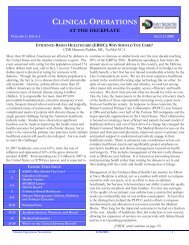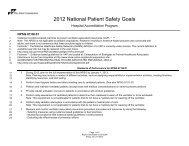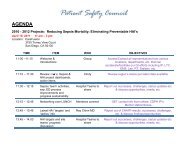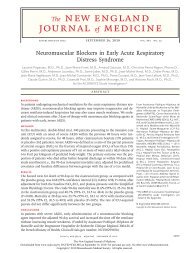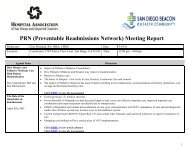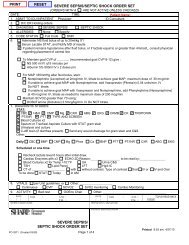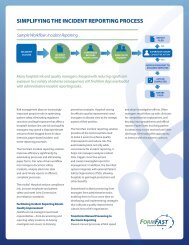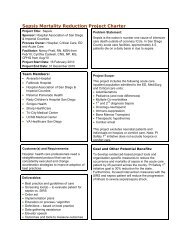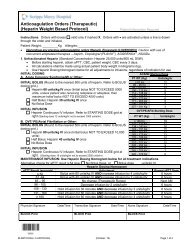Ventilator-Associated Pneumonia Prevention - Patientsafetycouncil ...
Ventilator-Associated Pneumonia Prevention - Patientsafetycouncil ...
Ventilator-Associated Pneumonia Prevention - Patientsafetycouncil ...
Create successful ePaper yourself
Turn your PDF publications into a flip-book with our unique Google optimized e-Paper software.
<strong>Ventilator</strong>-<strong>Associated</strong><br />
<strong>Pneumonia</strong> <strong>Prevention</strong><br />
December 15, 2010
Definitions ATS/IDSA 2005<br />
• Hospital-acquired <strong>Pneumonia</strong> (HAP) –<br />
pneumonia that occurs ≥ 48 hr after admission,<br />
and did not appear to be incubating at time of<br />
admission<br />
• <strong>Ventilator</strong>-associated <strong>Pneumonia</strong> (VAP) – type<br />
of HAP that develops more than 48 – 72 hr after<br />
endotracheal intubation<br />
Am J Respir Crit Care Med 2005; 171:388
<strong>Ventilator</strong><br />
<strong>Ventilator</strong> Circuit<br />
Humidification device<br />
Closed-suction device<br />
Endotracheal tube<br />
Oro-gastric tube
Risk Factors for VAP<br />
• Age >70 years<br />
• Chronic lung disease<br />
• Depressed consciousness<br />
• Aspiration<br />
• Chest surgery<br />
• Presence of an intracranial<br />
pressure monitor or NG tube<br />
• Hospitalization during fall / winter<br />
• Underlying illness<br />
• Mechanical ventilation for ARDS<br />
• Transport from the ICU for<br />
diagnostic or therapeutic<br />
procedures<br />
• Previous antibiotic exposure,<br />
esp. 3 rd gen. cephalosporins<br />
• Reintubation or prolonged<br />
intubation<br />
• H2 blocker or antacid therapy<br />
• Frequent vent. circuit changes<br />
• Paralytic agents<br />
Kollef Crit Care Med 2004; 32:1396
Highest Rates of VAP<br />
• Trauma ICU<br />
• Burn ICU<br />
• Neurosurgical ICU<br />
• SICU<br />
NNIS Am J Infect Control 2004; 32:470
Strategic Approaches to VAP<br />
<strong>Prevention</strong><br />
• Minimize the need for intubation<br />
• Minimize duration of mechanical ventilation<br />
• Reduce bacterial colonization of<br />
oropharynx, stomach, sinuses<br />
• Prevent reflux, micro-aspiration around ETT<br />
• Avoid use of contaminated equipment
Guidelines for VAP <strong>Prevention</strong><br />
• CDC 2003<br />
• AARC 2003<br />
• ATS/IDSA 2005<br />
• AMMI/CTS (Canada) 2008<br />
• CCCTG (Canada) 2008<br />
• AHRQ 2008<br />
• SHEA/IDSA 2008<br />
• IHI
Specific Strategies to Reduce VAP Incidence:<br />
Beyond the “<strong>Ventilator</strong> Bundle”<br />
Recommended -<br />
• Hand hygiene per CDC, WHO guidelines (IDSA, CDC, ATS)<br />
• Educate clinicians about VAP risks and prevention (IDSA, CDC, AHRQ, ATS, AARC)<br />
• Provide adequate staffing levels in ICU for vent patients (ATS)<br />
• NIV instead of intubation whenever possible (IDSA, CDC, AHRQ, ATS)<br />
• Daily sedation vacation or awakening (IHI, ATS)<br />
• Daily assess ability to tolerate spontaneous breathing (IHI, IDSA, ATS)<br />
• Keep head of bed elevated 30 - 45° (IHI, IDSA, CDC, AHRQ, ATS, CCCTG, AMMI)<br />
• Continuous aspiration subglottic secretions (IDSA, CDC, AHRQ, ATS, CCCTG, AMMI)<br />
• Antiseptic oral care (e.g. chlorhexidine 0.12%) (IDSA, CDC, AHRQ, CCCTG, AMMI)<br />
• Avoid unplanned extubation and reintubation (IDSA, CDC, ATS)<br />
• Maintain ETT cuff pressure at least 20 cmH 2 O (less than 30) (IDSA, ATS)<br />
• Oral, not nasal intubation (IDSA, CDC, ATS, CCCTG, AMMI)<br />
• Store, disinfect respiratory therapy equipment properly (IDSA, CDC)<br />
• Change vent circuit only if soiled, or new patient (IDSA, CDC, CCCTG, AMMI, AARC)
Specific Strategies to Reduce VAP Incidence:<br />
Beyond the “<strong>Ventilator</strong> Bundle”<br />
Probably Helpful –<br />
• Use PEEP in all ventilated patients<br />
• Drain circuit excess condensation (IDSA, CDC, ATS, AARC)<br />
• Avoid breaking the vent circuit as feasible (AARC)<br />
• Avoid antacids unless high risk stress ulcer (IDSA, ATS)<br />
• Early removal NGT, prefer OGT (ATS, CDC)<br />
• Minimize patient transport from ICU<br />
• Avoid gastric overdistention (IDSA)<br />
• Vaccination – pneumococcal, influenza (CDC)<br />
• Antimicrobial coated ETT (e.g. silver)<br />
• Use of polyurethane-cuffed ETTs<br />
• Limit antibiotic use
Specific Strategies to Reduce VAP Incidence:<br />
Beyond the “<strong>Ventilator</strong> Bundle”<br />
Unclear Role, Possibly Beneficial –<br />
• HME vs active humidification systems (AMMI)<br />
• Closed-system suction device vs open suctioning (CCCTG, AMMI, AARC)<br />
• Selective use of continuous lateral rotation beds (CCCTG, AMMI)<br />
• Early mobilization of the vent patient<br />
• Small-volume saline installation vs no saline with routine suctioning<br />
• Selective digestive decontamination<br />
• Probiotics<br />
• Prophylactic antibiotics at intubation, head injury
Getting From the Many Elements of VAP<br />
<strong>Prevention</strong> to an Organized Approach<br />
• Active surveillance program<br />
• Educate clinicians involved<br />
• Bundles<br />
• Order sets<br />
• Checklists<br />
• Teams<br />
• Audits of compliance<br />
• ? Other techniques



